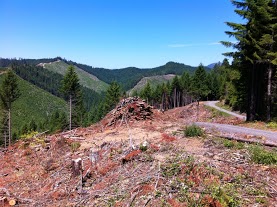When is a clearcut a clearcut?
By Chandra LeGue of Eugene, Oregon. Chandra originally came to Oregon in 1999 with a degree in biology, and earned a Masters in Environmental Studies from the University of Oregon. She has served with Oregon Wild since 2003, and is proud to engage in work protecting and restoring the forests and wildlands of her adopted home state.
We all know what clearcuts look like – the patchwork of private industrial timber lands stretching before us as we drive from the Willamette Valley to the coast, and which surround communities in the foothills of the Cascades or Coast Range.
Millions of acres of Oregon’s forests, both public and private, have been clearcut over the past century. The clearcuts we see today are mostly on privately-owned lands logged under Oregon’s weak state logging rules.
In the decades leading up to the Northwest Forest Plan which now governs western Oregon’s public forestlands – managed by the Forest Service and Bureau of Land Management (BLM) – hundreds of thousands of acres of old-growth forest were clearcut. We’ve been dealing with the results ever since: polluted water, degraded fish and wildlife habitat, threatened species, lost wilderness opportunities, and dense, unhealthy tree farms replanted after logging.
Since the mid-1990s, we’ve seen a necessary step away from destructive clearcutting and old-growth logging, at least in our public forests, and the land management agencies have shifted to restoring watersheds and forests degraded from past practices, including thinning dense young plantation stands.
This restoration thinning has enabled the Forest Service and BLM to meet timber targets established under the Northwest Forest Plan, and when carefully done, thinning young stands provides ecological benefits by helping develop some characteristics of natural forests more quickly over time. Thinning also produces jobs and wood products as a byproduct of ecological restoration.
In fact, Oregon Wild has won the Two Chiefs Award from the Forest Service and the Natural Resources Conservation Service one two occasions as part of collaborative group efforts restoring monospecies plantation stands: once in the Clackamas River watershed in the Mount Hood National Forest, and again in the Siuslaw National Forest in the Coast Range.
But this trend towards restoring young stands into more diverse, natural forests could change. Under principles for increased logging advanced by some forest scientists and the Department of the Interior, several pilot projects are beginning to be implemented on BLM lands in western Oregon.
Billed as “variable retention harvests,” this manner of logging closely resembles clearcutting, but embeds unlogged “retention areas,” equaling about 20 to 30 percent of the logged area. A few scattered trees may also be left.
The idea is this approach leaves more diversity and structure than a traditional clearcut, and may develop some shrub habitat. But the impacts on the forest are similar to a clearcut, especially when conducted in older forests.
The first pilot project to implement this “variable retention harvest” method, called the Buck Rising timber sale, is located in the North Myrtle Creek watershed southeast of Roseburg.

Unfortunately, opportunities to see more of these “sloppy” clearcuts won’t be in short supply. This summer, the White Castle Timber Sale – located in a beautiful forest at least a century old near the Buck Rising sale – is scheduled to be logged. Additional clearcut projects based on the variable retention principles are being planned in the Coos Bay, Eugene, and Salem BLM Districts as well.
We’re also dealing with a possible expansion of these damaging practices across the landscape. The BLM is currently analyzing ways to revise their management plan, and will consider using these principles. And Senator Wyden recently released a framework for developing federal legislation for these lands that also embraces these logging methods.
The forests impacted by these plans are often literally in our backyards. In fact, the Myrtle Creek watershed, where the Roseburg Pilot project is located, is one of the locales highlighted in the recent BLM Special Places report, a collaborative effort by Oregon Wild and the Klamath-Siskiyou Wildlands Center. And as more of these “variable retention harvest” projects are planned, your favorite backyard forest, secret fishing hole, hunting ground, or campsite on BLM land may also be affected.
Want to help out? Take action now:
• Tell Senator Wyden not to endorse clearcuts on Oregon’s public lands.
• Learn more about Oregon Wild’s Backyard Forests initiative and special places on BLM-managed lands, and share your stories and photos.
|
July 03, 2013
|
More Recent Posts | |
Albert Kaufman |
|
Guest Column |
|
Kari Chisholm |
|
Kari Chisholm |
Final pre-census estimate: Oregon's getting a sixth congressional seat |
Albert Kaufman |
Polluted by Money - How corporate cash corrupted one of the greenest states in America |
Guest Column |
|
Albert Kaufman |
Our Democrat Representatives in Action - What's on your wish list? |
Kari Chisholm |
|
Guest Column |
|
Kari Chisholm |
|
connect with blueoregon


